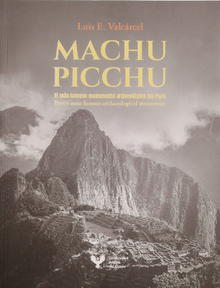
- Editorial:
- UNIVERSIDAD ANDINA DEL CUSCO
- Año de edición:
- 2023
- Materia
- Arqueología
- ISBN:
- 978-612-4392-65-8
- Páginas:
- 313
- Encuadernación:
- Rústica
MACHU PICCHU
EL MÁS FAMOSO MONUMENTO ARQUEOLÓGICO DEL PERÚ / PERU´S MOST FAMOUS ARCHAEOLOGICAL MONUMENT
VALCÁRCEL, LUIS E.
antes de comprar
antes de comprar
Cronológicamente, dice Valcárcel, el Estado incaico se desenvuelve entre los siglos x1 y xvi de la era cristiana. En los primeros doscientos años, los incas ensayan sus métodos en limitado espacio. Mas consolidadas sus instituciones básicas, el desarrollo alcanzó su máxima celeridad entre 1400 y 1500. El apogeo del Cusco coincide con el largo gobierno del noveno monarca, Pachacuti. Con él, la cultura peruana antigua deja marcadas huellas en el espíritu de la población aborigen y gran número de testimonios materiales, sobre todo en sus magnas construcciones de piedra. De entre estas, la que ha cobrado justa fama en todo el orbe es Machu Picchu, la prodigiosa "ciudad perdida". descubierta el 24 de julio de 1911 por el doctor Hiram Bingham, al frente de una expedición científica financiada en los Estados Unidos, y cuya biografía traza Valcárcel en un animado relato en el cual intervienen por igual la geografia, la etnografia, la antropología, la arquitectura, la religión y la historia política. Machu Picchu emerge de este relato como una de las más notables creaciones del espíritu humano.
Chronologically speaking, the Inca Empire developed, according to Dr. Valcárcel, between the eleventh and sixteenth centuries. During the first 200 years the Incas tested their methods within a limited area. Once their basic institutions were consolidated, the Inca culture developed rapidly and reached its peak between 1400 and 1500. The Cusco apogee coincides with the long reign of the ninth monarch, Pachacuti. Peruvian culture, under his guidance, not only left deep imprints on the spirit of the native population but also many material testimonies, especially its huge stone constructions. Among the latter, the one that has achieved worldwide fame is Machu Picchu, the marvelous "lost city" discovered by Dr. Hiram Bingham on July 24, 1911. Dr. Bingham led a scientific expedition financed in the United States, and Dr. Valcárcel relates, in a lively account, the discovery of Machu Picchu by this expedition: geography, ethnology, anthropology, architecture, religion, and political history all played an important role in the discovery and interpretation of the ruins of Machu Picchu. The Sacred City emerges from Dr. Valcárcel's study as one of the outstanding creations of the human spirit.

